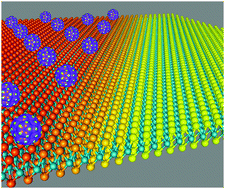当前位置:
X-MOL 学术
›
Chem. Soc. Rev.
›
论文详情
Our official English website, www.x-mol.net, welcomes your
feedback! (Note: you will need to create a separate account there.)
The organic–2D transition metal dichalcogenide heterointerface
Chemical Society Reviews ( IF 40.4 ) Pub Date : 2018-04-13 00:00:00 , DOI: 10.1039/c8cs00159f Yu Li Huang 1, 2, 3, 4, 5 , Yu Jie Zheng 4, 5, 6, 7 , Zhibo Song 1, 2, 3, 4, 5 , Dongzhi Chi 1, 2, 3, 4 , Andrew T. S. Wee 4, 5, 6, 7, 8 , Su Ying Quek 4, 5, 6, 7, 8
Chemical Society Reviews ( IF 40.4 ) Pub Date : 2018-04-13 00:00:00 , DOI: 10.1039/c8cs00159f Yu Li Huang 1, 2, 3, 4, 5 , Yu Jie Zheng 4, 5, 6, 7 , Zhibo Song 1, 2, 3, 4, 5 , Dongzhi Chi 1, 2, 3, 4 , Andrew T. S. Wee 4, 5, 6, 7, 8 , Su Ying Quek 4, 5, 6, 7, 8
Affiliation

|
Since the first isolation of graphene, new classes of two-dimensional (2D) materials have offered fascinating platforms for fundamental science and technology explorations at the nanometer scale. In particular, 2D transition metal dichalcogenides (TMD) such as MoS2 and WSe2 have been intensely investigated due to their unique electronic and optical properties, including tunable optical bandgaps, direct–indirect bandgap crossover, strong spin–orbit coupling, etc., for next-generation flexible nanoelectronics and nanophotonics applications. On the other hand, organics have always been excellent materials for flexible electronics. A plethora of organic molecules, including donors, acceptors, and photosensitive molecules, can be synthesized using low cost and scalable procedures. Marrying the fields of organics and 2D TMDs will bring benefits that are not present in either material alone, enabling even better, multifunctional flexible devices. Central to the realization of such devices is a fundamental understanding of the organic–2D TMD interface. Here, we review the organic–2D TMD interface from both chemical and physical perspectives. We discuss the current understanding of the interfacial interactions between the organic layers and the TMDs, as well as the energy level alignment at the interface, focusing in particular on surface charge transfer and electronic screening effects. Applications from the literature are discussed, especially in optoelectronics and p–n hetero- and homo-junctions. We conclude with an outlook on future scientific and device developments based on organic–2D TMD heterointerfaces.
中文翻译:

有机–2D过渡金属二硫杂化物异质界面
自首次隔离石墨烯以来,新型的二维(2D)材料为纳米级基础科学和技术探索提供了引人入胜的平台。特别是由于诸如MoS 2和WSe 2之类的2D过渡金属二硫化碳(TMD)具有独特的电子和光学特性,包括可调节的光学带隙,直接-间接带隙交叉,强自旋-轨道耦合等,已被广泛研究。,适用于下一代柔性纳米电子学和纳米光子学应用。另一方面,有机物一直是柔性电子产品的优良材料。可以使用低成本和可扩展的程序合成过多的有机分子,包括供体,受体和光敏分子。将有机物和2D TMD领域结合起来,将带来仅在两种材料中都没有的优点,从而实现更好,多功能的柔性设备。实现此类设备的核心是对有机2D TMD接口的基本了解。在这里,我们从化学和物理角度回顾了有机2D TMD接口。我们讨论了有机层与TMD之间界面相互作用的当前理解,以及界面处的能级对齐,特别关注表面电荷转移和电子屏蔽效应。讨论了文献中的应用,特别是在光电学和p–n异质结和同质结中。最后,我们对基于有机2D TMD异质接口的未来科学和设备发展进行了展望。
更新日期:2018-04-13
中文翻译:

有机–2D过渡金属二硫杂化物异质界面
自首次隔离石墨烯以来,新型的二维(2D)材料为纳米级基础科学和技术探索提供了引人入胜的平台。特别是由于诸如MoS 2和WSe 2之类的2D过渡金属二硫化碳(TMD)具有独特的电子和光学特性,包括可调节的光学带隙,直接-间接带隙交叉,强自旋-轨道耦合等,已被广泛研究。,适用于下一代柔性纳米电子学和纳米光子学应用。另一方面,有机物一直是柔性电子产品的优良材料。可以使用低成本和可扩展的程序合成过多的有机分子,包括供体,受体和光敏分子。将有机物和2D TMD领域结合起来,将带来仅在两种材料中都没有的优点,从而实现更好,多功能的柔性设备。实现此类设备的核心是对有机2D TMD接口的基本了解。在这里,我们从化学和物理角度回顾了有机2D TMD接口。我们讨论了有机层与TMD之间界面相互作用的当前理解,以及界面处的能级对齐,特别关注表面电荷转移和电子屏蔽效应。讨论了文献中的应用,特别是在光电学和p–n异质结和同质结中。最后,我们对基于有机2D TMD异质接口的未来科学和设备发展进行了展望。











































 京公网安备 11010802027423号
京公网安备 11010802027423号